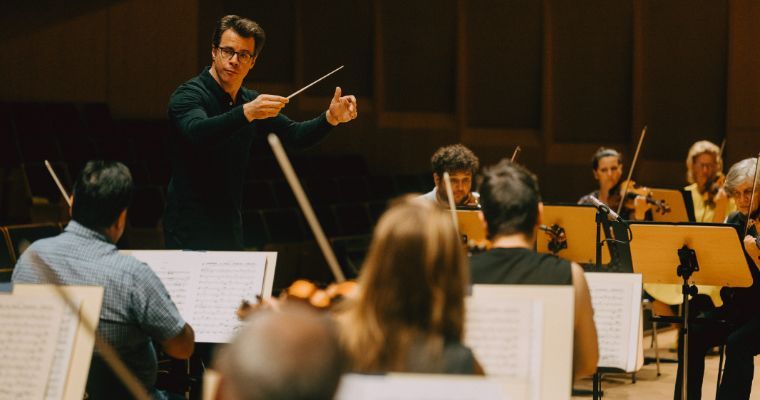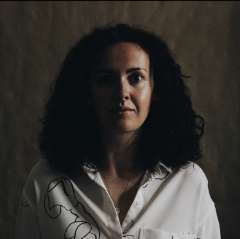Whether you love him or hate him, worship him or despise him, one thing is certain: Richard Wagner was and is one of the most important, influential, but also most polarising figures in the history of music. From his ardent admirers and loyal Wagnerians to his anti-Semitic sentiments and the appropriation of his music during the Nazi era, Wagner's works have been claimed by many.
Published in 2020, the book by New York music critic Alex Ross, Wagnerism: Art and Politics in the Shadow of Music, proves this through numerous fascinating examples and well-founded references that go far beyond a superficial knowledge of the composer, and thus open up a whole new insight into the “Cosmos Wagner”. Modern art, politics, literature – no one seems to be able to escape the influence of this controversial and problematic composer.
Likewise, the Bamberg Symphony has been inspired by this rich and wide-ranging biography of a somewhat different kind to present a series of concerts in which the mystery of Wagner is to be symphonically re-examined and explored. I spoke with their artistic director, Marcus Rudolf Axt, about the fascination Wagner holds for them and about the upcoming Wagner concerts, but also about how important it is to keep Wagner relevant, including in the 21st century.
“Wagner is a part of the musical repertoire that must also be considered and played by a symphony orchestra,” Axt says. “We have always done that. We regularly have overtures by Wagner in the concert programmes and also perform his operas in concert.” And indeed, the history of the Bamberg Symphony cannot escape Wagner; he is a fixture in the orchestra's concert activities. Almost all Wagner operas have been performed in concert under Jonathan Nott in Bamberg, and Der Ring des Nibelungen became an important milestone in the orchestra's history at the 2013 Lucerne Festival. But also, following the expiration of the copyright restricting performances of the work to the Festspielhaus, one of the first performances of Parsifal outside Bayreuth by their predecessor orchestra at the German Opera House in Prague in 1914, or Die Walküre led by Joseph Keilberth, which was performed as a guest performance of the Bayreuth Festival in Barcelona in 1955 and in which numerous musicians of the Bamberg Symphony participated, underpin the eventful performance history of Wagner's œuvre.
Now, however, they want to go new ways. Instead of more operas in concert, Axt plans to illuminate this subject from another side, to give it a different perspective. He, therefore, had to ask himself: “What can we do best in the Cosmos Wagner? And that is clearly the symphonic, the symphonic elements or specifically the symphonic effect of Wagner's music.” This realisation led to four concerts, which will be performed between late May and early June.
With The Ring Without Words, which will be performed at both the Bamberg Concert Hall and the Munich Isarphilharmonie, the orchestra hopes to continue its illustrious history of Wagner concerts. “What we are trying to do right now is to add a few words to The Ring Without Words. We want to address the symphonic impact of the whole thing in a kind of lab or workshop.” Thus, Lorin Maazel's 70-minute arrangement of the monumental work becomes a “Ring With Words”.
“Alex Ross' book really is a great source of inspiration and makes it clear how far Wagner has influenced the entire cultural field in the 20th century.” Axt mentions the many literary influences, such as Nietzsche and Schopenhauer, George Bernard Shaw and Thomas Mann, and thus offers an insight into the evening's programme: these influences are to be integrated into the concert in the form of quotations, “which are shown between individual pieces, sometimes in the text or during the music, in order to open up an additional horizon of understanding.”
The concert Die Welt nach Wagner ties in with this idea as well, according to Axt: “perhaps it's the most exciting project for which we are still in the middle of the creative process. That's why we have now come up with the title The World with Wagner”.
“We want to tell a story about the influence of Wagner's music on other compositions.” Axt points to the influences on Richard Strauss, the Adagietto from Mahler's Fifth Symphony, but also lesser-known works, such as the Nibelungen March by Gottfried Sonntag in which Wagner is quoted quite openly and unchanged. “The whole thing is combined with film excerpts in which Richard Wagner's music was used. We want to create cross-fades and interweave music, texts and images on the phenomenon of Wagner in an interdisciplinary and multimedia way to make the Wagner cosmos palpable.” Visually, the concept will be supported by a production by Nick and Clemes Prokop. “In 90 minutes we would like to destroy this usual reception, because everyone has their own prejudices or opinions about Wagner, and we will try to break this down and then put it together again.”
The final concert in the Wagner series is the monumental and visionary silent film classic Die Nibelungen by Fritz Lang from 1924, the first part of which, Siegfried, will be accompanied live by the Bamberg Symphony with the original film score by Gottfried Huppertz. “What Fritz Lang created is monumental and also somehow very modern. Also in the visual language and in the way the cuts were made. This film music is of course very inspired by Wagner and contains motifs that are very similar [to Wagner's leitmotifs] and quote them. But Lang has still found a language that is something of his own.”
This concert presents the orchestra with the challenge of a film orchestra, whose approximately 80 musicians, unlike in symphonic concerts, have to pay special attention to the compatibility of image and sound (music), to avoid the music running behind the image or vice versa. Fortunately, Lang's epic is very forgiving – “it has the generosity of not always having to be timed to the second” – and so the orchestra can get by without the so-called “click track technique”.
“Depending on audience response and interest, perhaps in two or three years,” says Axt, “the second part of the dilogy, Kriemhilds Rache, will also be performed.” And the other concerts are not to remain a one-off either. “For now, we are concentrating on Der Ring des Nibelungen with two concerts, and we are also thinking about how to link Tristan und Isolde with symbolism and impressionism, for example.” He also addresses Parsifal and the theme of spirituality, mentioning echoes of Czech compositions. Jakub Hrůša, the Czech Chief Conductor of the Bamberg Symphony, already referred to these similarities in the conceptual design of the concerts, and so they repeatedly discovered Wagner quotations in composers such as Dvořák, Suk or Smetana.

Hrůša, who is currently conducting his first complete Wagner opera, Lohengrin, at the Royal Opera House in London, “has completely immersed himself in this Wagner universe,” says Axt. So the programming for these Wagner concerts couldn't have happened at a better time. “Hrůša is a very creative mind and is interested in the programmes and how they are put together, always trying to convey a message,” confirms Axt, underlining the excellent creative partnership that has already existed for many years.
In the past, Axt and his team have repeatedly developed unusual and interdisciplinary projects that not only benefit subscribers, but also appeal to young people and students in an important university city like Bamberg and are intended to generate lasting interest. “Perhaps this project, this laboratory, will develop a little further over the next few years. Even in the 21st century, Wagner's music is still used as a creative anchor point. And that is what fascinates us!” With this creative reappraisal of Wagner's biography and his musical dramas, the question of their relevance arises, especially with regard to current discourses and the orchestra's educational mission to respond to the pressing issues of the 21st century.
“I think you have to do both, move with the times but keep the music current and reassess its relevance. That is also our cultural mission. Of course, we serve the classical symphony concerts, but we also have to consider how that can be developed further. How do we reach a different audience? How do we respond to what the world presents to us in the 21st century?” The upcoming season will be themed “Creation” and will put current issues such as climate change into a musical context. “As a symphony orchestra and a big player in the city, you have a mandate to be socially relevant. How can we give even more meaning and more content to what we offer?” Axt wonders. For him, it's a “beautiful challenge and a terrific task!”
Click here to find out more about the upcoming Wagner concerts.
This interview was sponsored by the Bamberg Symphony.
Translated into English by Elisabeth Schwarz


